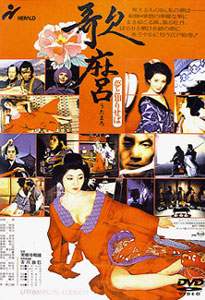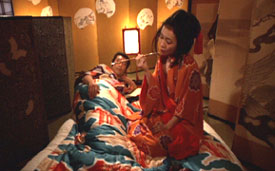 Beginning about 1969 but most obviously by the mid-1970s through early 1980s, a shrinking percentage of Japanese theatrical releases were jidai-geki or chambara (historicals or swordplay films) & an increasing number were pinku (soft-core pornography).
Beginning about 1969 but most obviously by the mid-1970s through early 1980s, a shrinking percentage of Japanese theatrical releases were jidai-geki or chambara (historicals or swordplay films) & an increasing number were pinku (soft-core pornography).
A few filmmakers began to mix pinku & chambara in an effort to attract two audiences at once, & some of these are today regarded as classics of kind, like Shintaro Katsu's "Hanzo the Razor" films mixing first-rate samurai action with second-rate sex.
At the time of this shift from elegant samurai films to sexploitation films, I was very disappointed, feeling acutely the end of Japanese cinema as the best in the world.
Fortunately the slump would not last, & even during that era when softcore dominated the cinema houses, there were legitimately artful films that transcended mere vulgarity, such as Nagisa Oshima's incredible The Empire of Passion; aka, In the Realm of Passion (Ai no borei, 1978). And even such clearly commercial exploitative films as Hellish Love (Seidan botan-doro, 1972) were in their own way quality films.
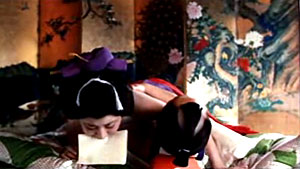 Still, at the time, it was hard for me to embrace what was still good in Japanese films. I was kind of ticked off that the type of film one associated with Kurosawa or Kobayashi seemed to be things of the past, & what we had instead was torture-porn. Still, at the time, it was hard for me to embrace what was still good in Japanese films. I was kind of ticked off that the type of film one associated with Kurosawa or Kobayashi seemed to be things of the past, & what we had instead was torture-porn.
And having no personal access to the future, I could not foresee a revival with such beautiful & humanistic samurai epics as The Twilight Samurai (Tasogare Seibei, 2002) or Hana (Hana yori mo naho, 2006).
So even apart from feminist sentiments, I felt acutely a certain "loss," that there would never again be such perfection in jidai-geki. So when I wrote film reviews through this period, I was frequently unfriendly to films that treated women as punching bags, which alas was in great part what pinku most expressed.
I wrote a killer-review of one pinku historical that had every rational basis for erotic content, for Utamaro's World (Utamaro yume to shiriseba, 1977) regards a famous shunga or erotic print artist. This is a physically beautiful film easy to criticize for getting the history wrong & for demeaning women, but in another frame of mind just as easy to praise.
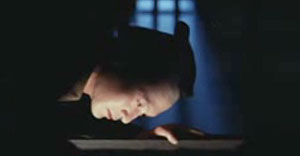 My negative points at the time included the fact that producer Kuzui Kinshiro had for a few years been trying to promote pornography as socially aware art when it wasn't. My negative points at the time included the fact that producer Kuzui Kinshiro had for a few years been trying to promote pornography as socially aware art when it wasn't.
His production of Masahiro Shinoda's violent recreation of Japan's matrical roots in Himiko (1974) was a stylized sexual tour de force that never in the least enlighted the audience about Japan's prehistoric lifestyle, & is simply one of Shinoda's worst films if not the worst.
And director Akio Jissoji's best known film was Mujo (This Transient Life; aka, The Passing Life, 1970), a dishonest view of incest, pretending to be criticism but really a lurid exploitation of its subject.
So I wrote most uncharitably at the time how "Together, these highly respected pornographers conspired to present a view of the Temmei-Kansei era (1781-1800) that is full of more lies than artistic liscense."
In retrospect I may not have been dead wrong, but I was definitely too narrow in my assessment, as there's much more going on in the film than I indicated.
T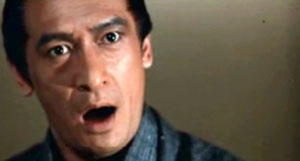 he key figure in this film, Kitagawa Utamaro (Shin Kishida), explores the Yoshiwara (pleasure district) of Edo as a voyeur, questing for inspiration. Kishida's performance is as pensive as it is perverse. he key figure in this film, Kitagawa Utamaro (Shin Kishida), explores the Yoshiwara (pleasure district) of Edo as a voyeur, questing for inspiration. Kishida's performance is as pensive as it is perverse.
I'd also frankly gone into the film expecting something closer to chambara with plenty of swordplay action. There was a little of that ingredient, but I felt cheated that it was too little, as though a film about an artist should have duels in it. Sensibly I should've faulted the film for having any duels at all! I definitely wasn't thinking clearly on this point.
A secondary character is a kabuki actor of great fame. He lives a secret life as a Robin Hood sort of thif called "Floating Bridge of Dreams," played by Mikijiro Hira. He is a protector & avenger for the inhabitants of the Yoshiwara, just the sort of character I could embrace.
His role is definitely of interest to martial arts film fans. We see him roof-fighting, performing bojutsu against a score of police, using tanto knife effectively against a samurai bodyguard's katana, & killing the bad guys in a grand one-against-all scene, always affecting a fighting style influenced by his parallel performances on the kabuki stage.
His nemesis, the samurai bodyguard (Shingo Yamashiro), ultimnately joins him in his fight against corrupt government officials. Afterward, they decide on a unique sort of double-suicide: they duel to the death, despite liking each other, or because of it.
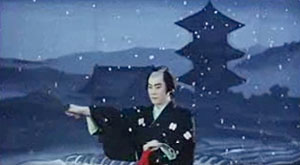 I felt upon first viewing of this film, when assessed as a samurai movie per se, that the great part of the film was the beautifully adapted kabuki style of swordplay & the whole story of Floating Bridge of Dreams. But this was way too small a part of Utamaro's World, the real focus of which was divided between sex scenes & Utamaro's daily life & tribulations. I felt upon first viewing of this film, when assessed as a samurai movie per se, that the great part of the film was the beautifully adapted kabuki style of swordplay & the whole story of Floating Bridge of Dreams. But this was way too small a part of Utamaro's World, the real focus of which was divided between sex scenes & Utamaro's daily life & tribulations.
Twenty-odd years later, the sex scenes seem a lot less pornographic to me, & a lot more attractively performed; while Kinshiro's performance as Utamaro is a very strong center for the film.
The main tale regards the government's persecution of Utamaro for his erotic art. He is arrested, sentenced to three days in prison, handcuffed for fifty days so that he cannot draw anything at all. His publisher (Mikio Narita) is likewise arrested, shouting at the police, "Art cannot be evil! You are evil!"
Historically it's true Utamaro was arrested, briefly imprisoned, & handcuffed as depicted. However, it was not for his erotic art, which is where the film got on my nerves for outright lying.
The truth would've been interesting enough for a fine film, but the producer & the director as pornographers had their personal axe to grind, which did not allow for truth. And that truth was that Utamaro was arrested for a purportedly libelous triptych of Hideyoshi Toyotomi, not for his shunga designs.
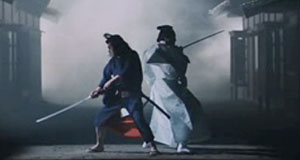 The triptych was perfectly chaste, but the laws governing portrays of Tokugawa ancestors were much stricter than laws governing erotic prints, & more apt to be enforced. This induced my former stiffnecked opinion: The triptych was perfectly chaste, but the laws governing portrays of Tokugawa ancestors were much stricter than laws governing erotic prints, & more apt to be enforced. This induced my former stiffnecked opinion:
"Why does Utamaro's World lie so blatantly about this? Perhaps because the makers wanted to create a misogynist sex movie & strike self-righteous poses about it. The posturing looks false when all we see are women being raped & enjoying it, bound & tortured to death, threatened with swords, & generally treated in sundry violent, demeaning ways."
I had not yet participated in s/m dungeons as would later occur in my life, & I wasn't always making a sensible distinction between sexual imagination, which is frequently violent yet fun, & actual rape, torture, or murder. I think my old opinion could still be sustained on one level: "With but one exception, men remain clad in the many sex scenes, but women are constantly naked. This is the double-standard that separates films about sexual joy from films which hate women. If eroticism were the point, why can't we see as much beefcake as cheesecake?"
That portion of my old review can stand, though I extended it a bit far in suggesting, "The makers of this film hate women, whereas it is dobutful that Utamaro hated women." I now prefer an analysis that faults the failure of male sexual imagination in this film, without asserting this failure is defacto indication of misogyny.
But I'm glad I wrote that review as I did at the time, if only to have these decades later a window into my thinking when I was a lot younger. It's quite an interesting thing to see into one's past thought processes, finding moments of brilliance mixed in with moments of foolishness. And reviews, in any case, should not be regarded either as truth or even as opinions so much as they should be regarded personal responses. No critic is ever totally correct, because we all have only our own point of view to work with, & points of view can evolve or change.
I wouldn't change what I said about history's Utamaro's art, however, & will close with an unrevised quote from my old review: "Utamaro's much more varied portraits of courtesans showed them with their children, with each other, at daily tasks, enjoying life apart from their work, & being admired by all true Edoites for their beauty, fashion sense, & artful achievements.
"Utamaro potrayed women with swords, hunting with falcons, & bathing in the sea. His erotic prints are marked by acute gentleness, occasional androgyny, variety, & consistent playfulness. Sometimes his work was bizarre (love-making with ghosts). The makers of Utamaro's World failed to capture Utamaro's joy of erotica. They made a film that insists sex of violent & dirty, not joyful."
Nevertheless, today, I can find room to praise a well-made film even if it is about violent & dirty sex rather than what I might prefer. I have no more illusions that historical films ever have much to do with history. The idea that Utamaro saw sex as primarily sadistic is untrue; this approach is about modern commercial porn, not about Utamaro. But it is absurd to insist on better accuracy in pinku when I'm not bothered that nice family films about happy-go-lucky samurai doing good deeds & protecting the meak is likewise complete B-S. Judging each film for what it is, rather than what I was expecting it would be, permits me now to admit Utamaro's World is a first-rate example of pinku jidai-geki.
copyright © by Paghat the Ratgirl
|
